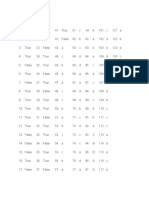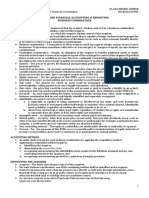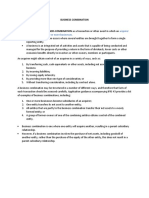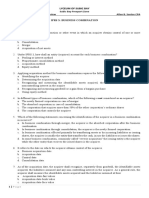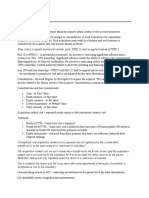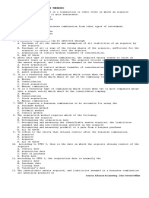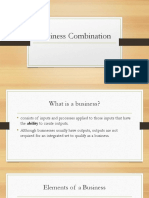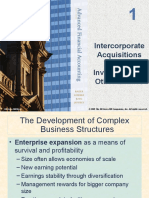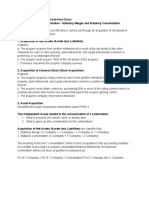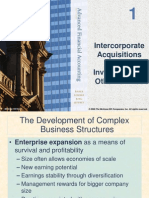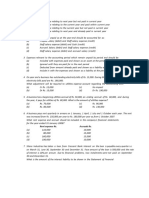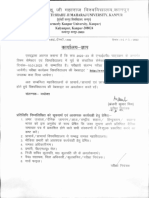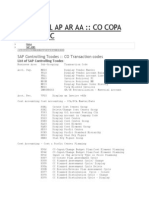Chapter 02
Uploaded by
wberniyaChapter 02
Uploaded by
wberniyaAdvanced Accounting
Fifth Edition
By Patrick E. Hopkins and Robert F. Halsey
Solution Manual
Chapter 2— Introduction to Business Combinations and the
Consolidation Process
1. The Scope section of FASB ASC 805-10-15 specifically excludes joint ventures from t7he
provisions of the standard. As a result, joint ventures are not required to be
consolidated and should be accounted for using the equity method.
2. The acquirer’s application of the recognition principle may result in recognizing some
assets and liabilities that the acquiree had not previously recognized as assets and
liabilities in its financial statements. For example, the acquirer may recognize previously
unrecognized intangible assets, such as a brand name, a patent, or a customer
relationship because, pre-acquisition, the acquiree developed them internally and
charged the related costs to expense.
3. FASB ASC 805-30-30-8 provides the following guidance relating to the transfer of assets
other than cash and stock: “The consideration transferred may include assets or
liabilities of the acquirer that have carrying amounts that differ from their fair values at
the acquisition date (for example, nonmonetary assets or a business of the acquirer). If
so, the acquirer shall remeasure the transferred assets or liabilities to their fair values as
of the acquisition date and recognize the resulting gains or losses, if any, in earnings.
However, sometimes the transferred assets or liabilities remain within the combined
entity after the business combination (for example, because the assets or liabilities were
transferred to the acquiree rather than to its former owners), and the acquirer
therefore retains control of them. In that situation, the acquirer shall measure those
assets and liabilities at their carrying amounts immediately before the acquisition date
and shall not recognize a gain or loss in earnings on assets or liabilities it controls both
before and after the business combination.”
To summarize, if the noncash asset will not remain with the consolidated group
following the acquisition, the acquirer can write up the asset before transfer and record
the resulting gain in income. In contrast, if the noncash asset remains with the
consolidated entity post-acquisition, it cannot be written up and no gain is recognized.
©Cambridge Business Publishers, 2023
Solutions Manual, Chapter 2 2-1
4. As required in FASB ASC 805-20-25-12, “Regardless of whether the acquiree is the lessee
or the lessor, the acquirer shall determine whether the terms of each of an acquiree’s
operating leases are favorable or unfavorable compared with the market terms of leases
of the same or similar items at the acquisition date. If the acquiree is a lessor, the
acquirer shall recognize an intangible asset if the terms of an operating lease are
favorable relative to market terms and a liability if the terms are unfavorable relative to
market terms. If the acquiree is a lessee, the acquirer shall adjust the measurement of
the acquired right-of-use asset for any favorable or unfavorable terms in accordance
with paragraph 805-20-30-24.”
FASB ASC 805-20-30-24 states, “For leases in which the acquiree is a lessee, the acquirer
shall measure the lease liability at the present value of the remaining lease payments, as
if the acquired lease were a new lease of the acquirer at the acquisition date. The
acquirer shall measure the right-of-use asset at the same amount as the lease liability as
adjusted to reflect favorable or unfavorable terms of the lease when compared with
market terms.”
5. FASB ASC 805-20-55-6 provides the following guidance: “The acquirer subsumes into
goodwill the value of an acquired intangible asset that is not identifiable as of the
acquisition date. For example, an acquirer may attribute value to the existence of an
assembled workforce, which is an existing collection of employees that permits the
acquirer to continue to operate an acquired business from the acquisition date. An
assembled workforce does not represent the intellectual capital of the skilled
workforce―the (often specialized) knowledge and experience that employees of an
acquiree bring to their jobs. Because the assembled workforce is not an identifiable
asset to be recognized separately from goodwill, any value attributed to it is subsumed
into goodwill.”
6. FASB ASC 805-20-55-7 provides the following guidance: “The acquirer also subsumes
into goodwill any value attributed to items that do not qualify as assets at the
acquisition date. For example, the acquirer might attribute value to potential contracts
the acquiree is negotiating with prospective new customers at the acquisition date.
Because those potential contracts are not themselves assets at the acquisition date, the
acquirer does not recognize them separately from goodwill. ”
7. FASB ASC 805-20-55-25 provides the following guidance: The agreement, whether
cancelable or not, meets the contractual-legal criterion. Additionally, because the
subsidiary establishes its relationship with customer through a contract, not only the
agreement itself but also the subsidiary’s relationship with the Customer meets the
contractual-legal criterion.
©Cambridge Business Publishers, 2023
2-2 Advanced Accounting, 5th Edition
8. FASB ASC 805-20-55-22 provides the following guidance: “An order or production
backlog arises from contracts such as purchase or sales orders. An order or production
backlog acquired in a business combination meets the contractual-legal criterion even if
the purchase or sales orders are cancelable.” Regardless of whether or not they are
cancelable, the purchase orders from 60 percent of the subsidiary’s customers meet the
contractual-legal criterion. Additionally, because the subsidiary has established its
relationship with 60 percent of its customers through contracts, not only the purchase
orders but also the subsidiary’s customer relationships meet the contractual-legal
criterion. Because the subsidiary has a practice of establishing contracts with the
remaining 40 percent of its customers, its relationship with those customers also arises
through contractual rights and therefore meets the contractual-legal criterion even
though the subsidiary does not have contracts with those customers as of the
acquisition date.
9. FASB ASC 805-20-55-23 provides the following guidance: “If an entity establishes
relationships with its customers through contracts, those customer relationships arise
from contractual rights. Therefore, customer contracts and the related customer
relationships acquired in a business combination meet the contractual-legal criterion….”
Because the subsidiary establishes its relationships with policyholders through insurance
contracts, the customer relationship with policyholders meets the contractual-legal
criterion, and can be identified as an intangible asset in the acquisition.
10. FASB ASC 805-10-55-35 provides the following guidance (the acquired company is
referenced as the “Target”): “In this Example, Target entered into the employment
agreement before the negotiations of the combination began, and the purpose of the
agreement was to obtain the services of the chief executive officer. Thus, there is no
evidence that the agreement was arranged primarily to provide benefits to Acquirer or
the combined entity. Therefore, the liability to pay $5 million is included in the
application of the acquisition method.”
11. FASB ASC 805-10-55-36 provides the following guidance (the acquired company is
referenced as the “Target”): “In other circumstances, Target might enter into a similar
agreement with the chief executive officer at the suggestion of Acquirer during the
negotiations for the business combination. If so, the primary purpose of the agreement
might be to provide severance pay to the chief executive officer, and the agreement
may primarily benefit Acquirer or the combined entity rather than Target or its former
owners. In that situation, Acquirer accounts for the liability to pay the chief executive
officer in its post-combination financial statements separately from application of the
acquisition method.”
©Cambridge Business Publishers, 2023
Solutions Manual, Chapter 2 2-3
12. Yes, the investor has gained effective control of the investee company by virtue of its
control of the Board of Directors. Even though it owns less than 50% of the outstanding
voting stock, the license agreement gives it control of the investee company and, as a
result, the investee must be consolidated with the investor.
13. The acquisition should be accounted for as a business combination, thus requiring
consolidation. It is not necessary for the business to have outputs (i.e., products and
sales). FASB ASC 805-10-55-4 defines a business as follows: “A business consists of
inputs and processes applied to those inputs that have the ability to contribute to the
creation outputs. Although businesses usually have outputs, outputs are not required
for an integrated set to qualify as a business.”
14. a. Assets and liabilities are recognized in a business combination if the applicable
definition in Concepts Statement No. 6 is met as of the acquisition date, and the
asset or liability is determined to be part of the business combination. After
recognition in the business combination is considered appropriate, the asset or
liability generally is measured at fair value in accordance with the principles of FASB
ASC 820.
b. Before any portion of the purchase price can be allocated to the Goodwill asset, you
must first ask if you are acquiring any intangible assets that are not recorded on the
acquiree’s balance sheet. A complete listing is in Exhibit 2.12. FASB ASC 805 requires
us to make a positive assessment whether any of these intangible assets were
valued by us in arriving at our purchase price for the acquiree and, if so, we must
assign that value to the intangible assets acquired before any of the purchase price
can be assigned to the Goodwill asset.
c. Intangible assets are typically valued at the present value of expected future cash
flows. We must, first, project the cash flows to be derived from the intangible asset.
Then, we need to discount those expected cash flows using an appropriate discount
rate. This is a very subjective process, as both the estimate of future cash flows and
the choice of the appropriate discount rate are difficult. We must make a reasonable
attempt, however, to value these intangible assets using a reasonable and
supportable methodology.
©Cambridge Business Publishers, 2023
2-4 Advanced Accounting, 5th Edition
15.
Intangible Asset Category Examples
Contract-based: Lease agreements, franchise agreements, licensing
agreements, construction contracts, employment
contracts, and mineral rights
Marketing-related: Brand names, trademarks, and Internet domain names
Customer-related: Customer contracts, relationships, and orders
Technology-based: Patent rights, computer software, and trade secrets
Artistic-related: Television programs, motion pictures and videos,
recordings, books, photographs, and advertising jingles
16. An indemnification asset represents the agreement by the seller to guarantee that the
acquirer will not suffer a loss as a result of the outcome of a contingency related to all or
part of a specific asset or liability. For example, the seller may indemnify the purchaser
against losses above a specified amount on a liability arising from a particular
contingency, such as a pending lawsuit.
The acquirer recognizes an indemnification asset at the same time that it recognizes the
indemnified item (the contingent liability, for example). In addition, both the
indemnification asset and the related liability are revalued subsequent to the acquisition
(FASB ASC 805-20-25-27 through 25-28 and FASB ASC 805-20-35-4).
17. FAASB ASC 805-20-55-20 identifies a number of customer-related intangible assets,
including the following:
a. Customer lists—a customer list acquired in a business combination normally meets
the separability criterion.
b. Order backlog—an order or production backlog acquired in a business combination
meets the contractual-legal criterion even if the purchase or sales orders are
cancelable.
c. Customer relationship—If an entity has relationships with its customers through
sales orders, they meet the contractual-legal criterion. Customer relationships also
may arise through means other than contracts, such as through regular contact by
sales or service representatives.
©Cambridge Business Publishers, 2023
Solutions Manual, Chapter 2 2-5
18. a. Restructuring plans typically include the termination of employees as departments
are merged, the divestiture of lines of businesses with related plant closing costs,
the relocation and training of employees, and the write-off of assets such as
Goodwill on the acquiree’s balance sheet that relate to previous acquisitions that
will no longer play a part in the consolidated company.
b. FASB ASC 805-20-25-2 provides the following guidance relating to planned
restructuring activities: “To qualify for recognition as part of applying the acquisition
method, the identifiable assets acquired and liabilities assumed must meet the
definitions of assets and liabilities in FASB Concepts Statement No. 6, Elements of
Financial Statements, at the acquisition date. For example, costs the acquirer
expects but is not obligated to incur in the future to effect its plan to exit an activity
of an acquiree or to terminate the employment of or relocate an acquiree’s
employees are not liabilities at the acquisition date. Therefore, the acquirer does not
recognize those costs as part of applying the acquisition method. Instead, the
acquirer recognizes those costs in its post-combination financial statements in
accordance with other applicable generally accepted accounting principles (GAAP).”
19. If financial statements are issued before the final allocations of the purchase can be
made, FASB ASC 805-10-55-16 allows us to use “provisional amounts,” that is, estimates
of those values. When the allocation adjustments are made, we prospectively adjust
those amounts, provided that the final measurement of all assets and liabilities is
completed within one year from the acquisition date. Also, during the measurement
period, the acquirer can recognize additional assets or liabilities if new information is
obtained about facts and circumstances that existed as of the acquisition date that, if
known, would have resulted in the recognition of those assets and liabilities as of that
date.
20. A a. No, a contingent liability for the employee litigation is not recognized at fair value on
the acquisition date because your attorney has determined that an unfavorable
outcome is reasonably possible, but not probable (ASC 450-20-25-2). Therefore,
your company would recognize a liability in the post-combination period when the
recognition and measurement criteria in ASC 450 are met.
b. The indemnification by the acquiree becomes an “indemnification asset” for the
purchaser and can be recognized as such on the consolidated balance sheet at the
same amount. Net assets acquired are, therefore, unaffected. Until the lawsuit is
settled or finally adjudicated, the contingent liability and the indemnification asset
must both be revalued at each balance sheet date and the change in value reflected
in income (see question 16). Since the asset and liability are offsetting, however,
their revaluation will have offsetting amounts in the income statement, leaving net
income unaffected.
©Cambridge Business Publishers, 2023
2-6 Advanced Accounting, 5th Edition
21. A a.
Equity investment 19,080,000
Common Stock 960,000
APIC 16,320,000
Contingent earnings liability 1,800,000
(to record the acquisition)
b.
Expense related to contingent earnings liability 720,000
Contingent earnings liability 720,000
(to record the increase in the expected value of the contingent earnings
liability)
c.
Expense related to contingent earnings liability 2,280,000
Contingent earnings liability 2,520,000
Cash 4,800,000
(to record payment of the contingent earnings liability)
22. B
Purchase price $4,000,000
Less: Fair value of assets acquired 3,840,000
Deferred tax liability (140,800) 3,699,200 ($640,000 x 22%)
Goodwill $300,800
23. According to paragraph 14 of the 1979 AICPA Issues Paper, proponents of pushdown
accounting view the change in control transaction as essentially the same as if the new
owners had purchased the net assets of an existing business and established a new
entity to continue that business. They believe that reporting on a new basis in the
separate financial statements of the continuing entity would provide information that is
more relevant to financial statement users. The change in control transaction is the
same as if the new owners purchased the net assets of an existing business and
established a new entity to continue the business. Opponents of pushdown accounting
believe that a change in ownership of an entity does not establish a new accounting
basis in its financial statements under the historical cost accounting framework. Since
the reporting entity did not acquire assets or assume liabilities as a result of the
transaction, the recognition of a new accounting basis based on a change in ownership,
rather than on a transaction on the part of the entity, is undesirable under a ”historical
cost framework.” (Of course, financial accounting principles reflect a mixed-attribute
measurement model, so any justification based on a historical cost justification would
need to describe how that information basis provides superior information to users of
financial statements.) Opponents of pushdown accounting also note that a new basis of
continued
©Cambridge Business Publishers, 2023
Solutions Manual, Chapter 2 2-7
accounting would be detrimental to interests of holders of existing debt and non-voting
capital stock who depend on comparable financial statements for information about
their investments and do not have access to other financial information. Push down
accounting would affect the ability of the entity to comply with debt covenants required
by outstanding debt and would materially alter the relationships in the entity's financial
statements.
24. Answer: c
In a (basket) net asset acquisition that does not constitute a business, as that term is
defined in FASB ASC 805 (“Business Combinations”), the total consideration paid for the
net assets is allocated to the individual net asset accounts on the basis of proportional
fair value, as follows:
Fair Value %FV Allocated
Production equipment 525 35% 540.75
Factory 600 40% 618.00
Licenses 375 25% 386.25
Total 1,500 100% 1,545.00
25. Answer: d
Goodwill is only recorded when the acquired net assets (or legal entity) constitutes a
business, as that term is defined in FASB ASC 805 (“Business Combinations”).
26. Answer: b
When acquired net assets (or a legal entity) constitute a business, as that term is
defined in FASB ASC 805 (“Business Combinations”), the individual identifiable acquired
net assets are reported at fair value on the acquisition date.
27. Answer: a
When acquired net assets (or a legal entity) constitute a business, as that term is
defined in FASB ASC 805 (“Business Combinations”), the amount of recognized goodwill
is equal to the fair value of the entire acquired business (i.e., $1,635 consideration
transferred) less the fair value of the identifiable net assets (i.e., $1,500). This results in
$135 of goodwill recognized on the acquisition date.
©Cambridge Business Publishers, 2023
2-8 Advanced Accounting, 5th Edition
28. Answer: a
Given that fair value of net assets approximates the book value of net assets and there
is no goodwill recognized, this means that the book value of net assets of the subsidiary
approximates the overall value of the consideration transferred for the company (i.e.,
$196,000). Given that the parent company transferred 10,000 shares, this means that
the per share value for the parent company stock is $19.60/share (i.e.,
$196,000/10,000).
29. Answer: c
Given that fair value of net assets approximates the book value of net assets and there
is no goodwill recognized, this means that the book value of net assets of the subsidiary
approximates the overall value of the consideration transferred for the company (i.e.,
$196,000). This means that the investment account equals $196,000 on the acquisition
date.
30. Answer: c
Goodwill is equal to the difference between the value of the acquired entity as a whole
minus the fair value of the acquiree’s individual net assets. In this case, the fair value of
the acquiree entity is the value of the stock transferred as consideration (i.e., $28 x
30,000 shares = $840,000). The fair value of the individual net assets is $565,600, which
means the goodwill is $274,400 (i.e., $840,000 – $565,600).
31. Answer: a
The amount recorded for the investment account is the value of the consideration
transferred in exchange for the investee’s common stock (i.e., $28 x 30,000 shares =
$840,000).
32. Answer: d
A business is “An integrated set of activities and assets that is capable of being
conducted and managed for the purpose of providing a return in the form of dividends,
lower costs, or other economic benefits directly to investors or other owners, members,
or participants.” It is not necessary that the investee company currently produce
products or generate a positive return. All that is necessary is that it
a. has begun planned principal activities,
b. has employees, intellectual property, and other inputs and processes that could be
applied to those inputs,
c. is pursuing a plan to produce outputs, and
d. will be able to obtain access to customers that will purchase the outputs.
©Cambridge Business Publishers, 2023
Solutions Manual, Chapter 2 2-9
33. Answer: b
Company A has a controlling financial interest in both Companies B (85%) and C (85% x
65% = 55.25%). Therefore B and C should be consolidated with A.
34. Answer: a
By holding 11,000 shares, former company B shareholders will own 55% (i.e., 11,000 /
(11,000 + 9,000) of the common stock after the transaction, suggesting they control the
company and can elect controlling Board within the next two years.
35. Answer: b
Direct fees have no effect on recording the business combination; these costs are simply
expensed as part of operating expenses for the period in which they are incurred. The
entry is as follows:
Expenses 144,000
Payables or cash (for direct acquisition costs) 144,000
Costs of registering and issuing securities are deducted from contributed capital; thus,
they have no effect on the investment account. The fair value of the common stock that
is issued (i.e., $7,040,000 = 640,000 shares x $11.00/share) will equal the amount of the
net assets that will be recognized in a business combination. The entry is as follows:
Investment in Investee 7,040,000
Common Stock ($1 par) 640,000
APIC 6,620,000
Payables or cash (for registration costs) 80,000
36. Answer: d
A controlling investment in an investee company’s common stock is accounted for in an
equity investment account on the pre-consolidation books of the investor company.
Thus, there is no separate pre-consolidation recognition of goodwill. The process of
consolidation will eliminate the investment account and replace it with the fair value of
the net assets of the subsidiary in the post-consolidation financial statements.
©Cambridge Business Publishers, 2023
2-10 Advanced Accounting, 5th Edition
37. Answer: c
The amount of goodwill implicit in an acquisition-date controlling investment in a
subsidiary is equal to the fair value of the entire subsidiary (i.e., $1,200,000) minus the
fair value of the identifiable net assets (FVINA). According to the facts, the book value
of the identifiable net assets is equal to $840,000. The only identifiable difference
between fair value and book value is $300,000 related to property and equipment.
Thus, the FVINA is equal to $1,140,000 (i.e., $840,000 + $300,000). Therefore, goodwill
is equal to $60,000 (i.e., $1,200,000 - $1,140,000).
38. Answer: b
In the case where (1) the fair value of the identifiable net assets of a subsidiary equals
the book value of identifiable net assets of the subsidiary, and there is no recorded
goodwill or bargain acquisition gain, then the investment account will equal the book
value of net assets of the subsidiary (i.e., which also equals the stockholders’ equity of
the subsidiary). Net assets equals $324,000 (i.e., CS, $36,000 + APIC, $252,000 + RE,
$36,000).
39. Answer: a
In the absence of profits (losses) on intercompany transactions, the investment account
at any point in time can be computed by taking p% of the book value of net assets
(BVNA) of the subsidiary and adding the unamortized p% acquisition accounting
premium (AAP). In this problem, p% = 100%. On the acquisition date, the unamortized
AAP is equal to the following (note that the amounts are expressed in debits and
credits):
AAP
Dr (Cr)
Receivables & Inventories 18,000
Land (9,000)
Property & Equipment 36,000
Goodwill 45,000
Liabilities 12,600
Total AAP 102,600
100% BVNA(S) + 100% AAP = $324,000 + $102,600 = $426,600
40. Answer: b
Consolidated financial statements must be prepared by a company that has a
“controlling financial interest” in other entities. In this case, Sun also prepares stand-
alone financial statements (perhaps for a bank or other creditor). There is no evidence
that Sun has a controlling financial interest in another entity.
©Cambridge Business Publishers, 2023
Solutions Manual, Chapter 2 2-11
41. Answer: b
Assuming no intercompany payables/receivables, on the acquisition date, there are only
two consolidating journal entries required: [E] and [A]. The [E] entry eliminates the book
value of net assets of the subsidiary (i.e., which equals reported stockholders’ equity)
from the investment account. Stockholders’ equity of the investee equals $440,000
(i.e., CS $96,000 + APIC $120,000 + RE $224,000). This means the [A] credit to the
investment account must have been $256,000 (i.e., $696,000 - $440,000).
42. B Answer: d
Generally speaking, in a nontaxable transaction, the pre-acquisition tax bases of the
subsidiary’s net assets carry forward to the post-acquisition tax books. This can result in
deferred taxes if the recognized fair values have temporary differences from the carried
forward tax bases. In this case, the only asset that has a different tax basis from its
newly recognized fair value is noncurrent assets with a fair value that is $39,000 greater
than its previous book value and tax basis. The deferred tax liability on this $39,000
temporary difference is $7,800 (i.e., 20% x $39,000). Therefore, including the deferred
tax, the fair value of the identifiable net assets (FVINA) for the subsidiary is equal to
$135,200 (i.e., BVINA $104,000 + noncurrent asset AAP $39,000 – deferred tax liability
AAP $7,800). Goodwill is equal to the fair value of the entire subsidiary minus the
FVINA, which equals $72,800 (i.e., FV subsidiary $208,000 – FVINA $135,200).
43. B Answer: c
Generally speaking, in a taxable transaction, the post-acquisition tax bases of the
subsidiary’s net assets are equal to the fair value of the net assets of the subsidiary.
Given no difference in financial versus tax bases, this means that there are no deferred
taxes recognized pursuant to the acquisition. In this problem, the only asset that has a
different tax basis from its newly recognized fair value is noncurrent assets with a fair
value that is $39,000 greater than its previous book value and tax basis. Therefore, the
fair value of the identifiable net assets (FVINA) for the subsidiary is equal to $143,000
(i.e., BVINA $104,000 + noncurrent asset AAP $39,000). Goodwill is equal to the fair
value of the entire subsidiary minus the FVINA, which equals $65,000 (i.e., FV subsidiary
$208,000 – FVINA $143,000).
44. Answer: d
After a change of control event, the acquiree has the option to apply pushdown
accounting in its separate pre-consolidation financial statements. This election is
irrevocable and has no impact on the requirement that the parent company prepare
consolidation financial statements that incorporate all entities the parent controls. The
pushdown process results in the subsidiary recording the effects of the AAP on its pre-
consolidation books. This will result in a subsidiary’s pre-consolidation individual net
assets being reported at fair value, consistent with FASB ASC 805.
©Cambridge Business Publishers, 2023
2-12 Advanced Accounting, 5th Edition
45. a. The cost is allocated to the acquired net assets based on relative fair values:
Book Allocated
Value Fair Value %FV Cost
Production equipment 600 240 5.0% 230
Factory 3,000 2,400 50.0% 2,300
Land 200 1,200 25.0% 1,150
Patents - 960 20.0% 920
3,800 4,800 100.0% 4,600
This results in the following journal entry:
Production equipment 230
Factory 2,300
Land 1,150
Patents 920
Cash 4,600
(to record purchase of the assets and assumption of the
liabilities that does not qualify as a business)
b.
Production equipment 240
Factory 2,400
Land 1,200
Patents 960
Goodwill 100
Expenses (transaction costs) 100
Cash 4,600
Contingent consideration liability 400
(to record purchase of the assets and assumption of the
liabilities that qualifies as a business)
©Cambridge Business Publishers, 2023
Solutions Manual, Chapter 2 2-13
46. a.
Cash 1,120
Accounts receivable 2,240
Inventories 4,480
PPE, net 11,200
Accounts payable 2,240
Accrued liabilities 3,360
Long-term liabilities 4,480
Cash 8,960
(to record purchase of the assets and assumption of the
liabilities that constitute a business
b.
Equity investment 8,960
Cash 8,960
(to record the acquisition of the investee’s common stock)
47. a.
Cash 1,120
Accounts receivable 2,240
Inventories 4,480
PPE, net 15,680
Customer List 3,360
Accounts payable 2,240
Accrued liabilities 3,360
Long-term liabilities 4,480
Cash 16,800
(to record purchase of the assets and assumption of the
liabilities of a business)
b.
Equity investment 16,800
Cash 16,800
(to record purchase of the assets and assumption of the
liabilities of a business)
©Cambridge Business Publishers, 2023
2-14 Advanced Accounting, 5th Edition
48. In both parts of this problem, the value of the common stock issued by the investor
company is the same: $232,750 (i.e., 6,650 shares x $35/share). On the investor’s
books, this is split between “Common stock ($1 par)” for $6,650 and “Additional paid-in
capital” for $226,100. The difference between parts a and b is whether (a) the investor
recognizes the investee’s individual net assets at fair value or (b) an investment account.
When the investor recognizes the individual net assets in part a, it will also recognize
goodwill implicit in the acquisition. The goodwill is equal to $15,750 (i.e., FV of investee,
$232,750 – FV of the identifiable net asset of the investee, $217,000). In part b, we only
recognize the investment account in the pre-consolidation financial statements of the
acquirer; thus, the goodwill is inside the investment account and only becomes part of
the investor’s financial statements after consolidation.
a. The journal entry to record the acquisition of the net assets follows:
Receivables & Inventories 31,500
Land 105,000
Property & Equipment 91,000
Trademarks & Patents 56,000
Goodwill 15,750
Liabilities 66,500
Common Stock ($1 par) 6,650
APIC 226,100
The effects of this entry are reflected in the FV Investee column in the following
worksheet:
(BV) (FV)
Dr. (Cr) Investor Investee Post-Acqu
Receivables & Inventories $ 70,000 $ 31,500 $ 101,500
Land 140,000 105,000 245,000
Property & Equipment 157,500 91,000 248,500
Trademarks & Patents 56,000 56,000
Investment in Investee 0
Goodwill 15,750 15,750
Total Assets $ 367,500 $ 299,250 $ 666,750
Liabilities $ 105,000 $ 66,500 $ 171,500
Common Stock ($1 par) 14,000 6,650* 20,650
APIC 196,000 226,100* 422,100
Retained Earnings 52,500 - 52,500
Total Liabilities & Equity $367,500 $ 299,250 $ 666,750
* Taken together, Common Stock and APIC equal the $232,750 fair value of consideration given up
for the subsidiary’s net assets.
©Cambridge Business Publishers, 2023
Solutions Manual, Chapter 2 2-15
b. The journal entry to record the acquisition of the common stock of the investee
follows:
Investment in Investee 232,750
Common Stock ($1 par) 6,650
APIC 226,100
(BV) (FV)
Dr. (Cr) Investor Investee Post-Acqu.**
Receivables & Inventories $ 70,000 $ 70,000
Land 140,000 140,000
Property & Equipment 157,500 157,500
Trademarks & Patents 0
Investment in Investee $ 232,750 232,750
Goodwill 0
$ 367,500 $ 232,750 $ 600,250
Liabilities $ 105,000 $ 105,000
Common Stock ($1 par) 14,000 $ 6,650 20,650
APIC 196,000 226,100 422,100
Retained Earnings 52,500 52,500
Total Liabilities & Equity $367,500 $ 232,750 $ 600,250
** = Pre-consolidation
* Taken together, Common Stock and APIC equal the $232,750 fair value of consideration given up
for the subsidiary’s net assets.
49. In millions
Purchase price $33,166
Fair value of tangible & intangible assets acquired $38,845
Fair value of liabilities assumed (26,548) 12,297
Goodwill $20,869
50. a. Goodwill = $15,000,000 - $5,250,000 - $3,000,000 - $3,750,000 = $3,000,000. The
acquisition costs are expensed under GAAP (FASB ASC 805-10-25-23).
b. Goodwill is not amortized like other intangible assets. Instead, it remains on the
balance sheet until management deems it to be impaired, at which time it is written
down.
c. Allocating more of the purchase price to goodwill reduces the allocation to assets
that are depreciated or amortized and, therefore, reduces the depreciation and/or
amortization expense hitting their income statements subsequent to the acquisition.
©Cambridge Business Publishers, 2023
2-16 Advanced Accounting, 5th Edition
51. a. The amounts relating to working capital, inventories and PPE assets are the fair
values of those assets on the acquisition date. These amounts reflect the book
values of those assets on DuPont’s balance sheet plus the AAP, the difference
between fair value and book value. These are the amounts that will appear on the
consolidated balance sheet relating to DuPont, and the reported amounts will be the
sum of these values plus the book value of these assets on Dow’s balance sheet on
the acquisition date.
b. In-process research and development (IPRD) assets relate to the acquisition-date
value of research projects currently in process and during their developmental
stages (i.e., before the research projects have reached technological feasibility).
Under current GAAP, investors value and recognize IPRD assets acquired in a
business combination at their fair values just like any other assets acquired (FASB
ASC 350-30-30-1). After initial recognition, tangible net assets used to support
research and development activities (e.g., R&D building and associated equipment)
are accounted for in accordance with their nature (i.e., they are
depreciated/amortized). Intangible research and development assets, on the other
hand, should be considered indefinite-lived (i.e., not amortized) until the associated
research and development activities are either completed (then, the intangible
assets are amortized over the life of the related patent or copyright) or abandoned
(in which case they are written off in the year of abandonment). Acquired intangible
IPRD assets are included in the annual goodwill impairment tests (FASB ASC 350-20-
35-15).
c. The value assigned to Goodwill is not computed directly. Instead, it is computed as a
residual amount (i.e., the amount left over after all other assets and liabilities have
been identified and valued).
d. Because of the complexity inherent in business combinations, it is not uncommon
for the accounting to take some time to complete. FASB ASC 805-10-25-13 through
25-19 permits companies to use “provisional” amounts, and to retrospectively adjust
those amounts when better information becomes available, provided that the final
measurement of all assets and liabilities is completed within one year from the
acquisition date. Also, during the measurement period, the investor can recognize
additional assets or liabilities if new information is obtained about facts and
circumstances that existed as of the acquisition date that, if known, would have
resulted in the recognition of those assets and liabilities as of that date. The
adjustments are recognized prospectively (i.e., not retroactively), with the
incremental adjustment fully recognized in the period in which the measurement
was changed. Therefore, if the measurements were revised during the quarter
ended December 31, 2017, the adjustment will be fully reflected in DowDuPont’s
quarterly financial statements for the three months ended December 31, 2017.
©Cambridge Business Publishers, 2023
Solutions Manual, Chapter 2 2-17
52. a. The arguments in favor of Company A as the acquirer are the following:
i. It issued the stock.
ii. Its CEO will become CEO of the combined company.
The arguments in favor of Company B as the acquirer are the following:
i. Its Chairman will become Chairman of the combined company.
ii. Its CFO will become CFO of the combined company.
On balance, it would appear that Company A is the acquirer. Its CEO will be the chief
executive of the combined entity, and, in three years, Company A’s Chairman will
become the new Company Chairman as well. During the interim, neither company
can control the strategic direction of the combined company since each elects one-
half of the Board of Directors.
b. The allocation of the purchase price is quite different for the two potential acquirers:
If Company A If Company B
is deemed to be is deemed to be
the Accounting Acquirer the Accounting Acquirer
Purchase Price $ 14.4 billion $ 14.4 billion
Identifiable tangible net assets (3.0 billion) (7.2 billion)
Identifiable intangible assets (6.0 billion) (3.6 billion)
Goodwill $ 5.4 billion $ 3.6 billion
If Company B is the accounting acquirer and Company A is the subsidiary, more of
the purchase price will be allocated to the fair value of total identifiable tangible and
intangible net assets (i.e., $10.8 billion). Both of these categories are usually
depreciated or amortized (e.g., except for land and some indefinite-lived intangible
assets). As a result, more of the purchase cost will likely hit the consolidated income
statement (Goodwill is not amortized, and becomes an expense only if impaired).
Also, if Company B is the acquirer, less Goodwill asset will be recognized. The
determination of an acquirer is often not a difficult issue. But, when it is, it can be a
significant one.
continued
©Cambridge Business Publishers, 2023
2-18 Advanced Accounting, 5th Edition
b. continued
This analysis is made solely from a financial perspective. There are other significant
implications of the choice of the acquirer, including
The acquirer may get to name the combined company with its name or using its
name first.
The image of the combined company in the market place may be different
depending on which company is viewed as the acquirer.
The acquirer’s philosophies and modes of operation may dominate the
combined company.
The acquirer may get the choice of the home office.
The acquirer’s employees may feel a sense of superiority. Conversely, the
acquiree’s employees may feel like they’ve been taken over. This can cause real
morale problems if not handled well.
53. a.
Equity investment 280,000
Common stock 56,000
Additional paid-in capital 224,000
(to record the acquisition)
b.
[E] Common stock 56,000
Retained earnings 140,000
Equity investment 196,000
(to eliminate the Stockholders’ Equity of the subsidiary on
the acquisition date)
[A] PPE (net) 84,000
Equity investment 84,000
(to record the [A] assets purchased on the acquisition
date)
©Cambridge Business Publishers, 2023
Solutions Manual, Chapter 2 2-19
54. a.
Equity investment 255,000
Cash 255,000
(to record the acquisition)
b.
[E] Common stock 85,000
Retained earnings 51,000
Equity investment 136,000
(to eliminate the Stockholders’ Equity of the subsidiary on
the acquisition date)
[A] Patent 102,000
Goodwill 17,000
Equity investment 119,000
(to record the [A] assets purchased on the acquisition
date)
55. a. Balance of Equity Investment account:
Purchase price 345,000
Cumulative net income of subsidiary 287,500
Cumulative dividends received from subsidiary (115,000)
Balance of Equity Investment account 517,500
b. The Equity Investment account is comprised of the amortized acquisition-date fair
values of the net assets of the subsidiary ($264,500, which happen to equal the book
values) and the carrying amount of the Goodwill asset ($80,500). It doesn’t matter
how long management believes goodwill will last; it is not amortized.
56. a. No, this is the fair value of these assets. The [A] consolidation journal entry records
the difference between the fair value and the book value of these assets on the
acquiree’s acquisition-date balance sheet.
b.
[A] Goodwill 14,059
Intangible Assets 63,927
Equity Investment 77986
(to record the intangible assets)
©Cambridge Business Publishers, 2023
2-20 Advanced Accounting, 5th Edition
c. The identifiable net asset values estimated for November 20, 2019 were based on
the best estimates management could identify as of the prior financial statement
date. Companies have a period of one year after the acquisition date to reduce the
measurement error in those estimates. Despite the fact these measurements are
adjusted after the acquisition date, the measurements are supposed to be based on
the conditions that existed on the acquisition date. In this case, the largest
adjustments decreased property plant and equipment and intangible assets with a
large decline in deferred income tax liabilities. Because goodwill is simply a residual
calculated as the difference between the fair value of consideration transferred and
the fair value of identifiable net assets acquired, goodwill is going to change as the
overall estimated value of identifiable net assets changes. In this case, goodwill
decreased by approximately $1.9 billion because the fair value of identifiable net
assets increase by approximately $1.9 billion.
57.A a.
The fair value of the identifiable intangible asset related to IPR&D was
determined using an income approach, through which fair value is estimated
based upon the asset’s probability adjusted future net cash flows, which reflects
the stage of development of the project and the associated probability of
successful completion. The net cash flows were then discounted to present value
using a discount rate of 11.5%.
The fair value of the contingent consideration was determined utilizing a
probability-weighted estimated cash flow stream using an appropriate discount
rate dependent on the nature and timing of the milestone payment.
b. The income approach (sometimes referred to as discounted cash flow or DCF
approach) involves both the projection of cash flows and the choice of an
appropriate discount rate. In its assignment of fair values to the assets acquired and
the liabilities assumed in the Afferent acquisition, it appears that the fair values were
likely determined using an income approach. This is not uncommon for intangible
assets. Remember this next time you look at a fair value assignment table for
business combinations.
c. The total possible contingent payments for achievement of "clinical development
and commercial milestones" related to the Afferent acquisition are $750 million. The
acquisition-date fair value of these potential future payments is $223 million. The
Afferent transaction includes these contingent (future) payments instead of cash
consideration because there was a difference in belief between Merck and the
selling shareholders of Afferent about the value of the IPRD. A common way for
these negotiation-related disagreements to be settled is to include contingent
consideration instead of cash or stock.
©Cambridge Business Publishers, 2023
Solutions Manual, Chapter 2 2-21
d.
Contingent consideration liability 223
Loss on acquisition contingency 527
Cash 750
(to record settlement of acquisition contingency)
58. a. Goodwill is equal to the difference between the fair value of an acquiree company
and the fair value of the acquiree’s identifiable net assets. In this case, the fair value
of the acquiree company is $1,644,000 and the fair value of the acquiree’s
identifiable net assets is $1,370,000 (i.e., CS of $137,000 + APIC of $274,000 + RE of
$411,000 + P&E AAP of $205,500 + Licenses AAP of $342,500). Therefore, goodwill
is equal to $274,000.
b.
Property & Equipment, net 205,500
Licenses 342,500
Goodwill 274,000
Pushdown equity 822,000
(entry required to record the effects of the AAP on the
subsidiary’s books)
Retained earnings 411,000
Pushdown equity 411,000
(entry required to eliminated retained earnings and establish
pushdown-type contributed capital)
c.
[E] Common stock 137,000
APIC 274,000
1,233,00
Pushdown equity 0
1,644,00
Equity investment 0
©Cambridge Business Publishers, 2023
2-22 Advanced Accounting, 5th Edition
d.
Consolidation Entries
Parent subsidiary Dr Cr Consolidated
Assets:
Cash & receivables $1,096,000 $137,000 $1,233,000
Inventory 822,000 274,000 1,096,000
Property & Equipment, net 3,151,000 1,267,250 4,418,250
Equity investment 1,644,000 [E] 1,644,000 0
Licenses - 376,750 376,750
Goodwill - 274,000 274,000
$6,713,000 $2,329,000 $7,398,000
Liabilities and stockholders'
equity:
Current liabilities $548,000 $205,500 $753,500
Other liabilities 411,000 - 411,000
Note payable - 479,500 479,500
Common stock 2,287,900 137,000 [E] 137,000 2,287,900
APIC 1,959,100 274,000 [E] 274,000 1,959,100
Retained earnings 1,507,000 - 1,507,000
Pushdown equity 1,233,000 [E] 1,233,000
$6,713,000 $2,329,000 1,644,000 1,644,000 $7,398,000
©Cambridge Business Publishers, 2023
Solutions Manual, Chapter 2 2-23
59. a. 30,000 shares x $17.40 market price per share = $522,000
b.
[E] Common stock 104,400
APIC 156,600
Retained earnings 261,000
Equity investment 522,000
(to eliminate the stockholders’ equity of the subsidiary
on the acquisition date)
c.
Parent subsidiary Dr Cr Consolidated
Assets
Cash $174,000 $87,000 $261,000
Accounts receivable 261,000 174,000 435,000
Inventory 435,000 348,000 783,000
Equity investment 522,000 [E] 522,000
PPE, net 870,000 522,000 1,392,000
$2,262,000 $1,131,000 $2,871,000
Liabilities and Equity
Accounts payable $87,000 $87,000 $174,000
Accrued liabilities 174,000 174,000 348,000
Long-term liabilities 696,000 348,000 1,044,000
Common stock 261,000 104,400[E] 104,400 261,000
APIC 435,000 156,600[E] 156,600 435,000
Retained earnings 609,000 261,000[E] 261,000 609,000
$2,262,000 $1,131,000 522,000 522,000 $2,871,000
©Cambridge Business Publishers, 2023
2-24 Advanced Accounting, 5th Edition
60. a. 80,000 shares x $14 market price per share = $1,120,000
b.
[E] Common stock 140,000
APIC 210,000
Retained earnings 420,000
Equity investment 770,000
(to eliminate the Stockholders’ Equity of the subsidiary
on the acquisition date)
[A] Patent 210,000
Goodwill 140,000
Equity investment 350,000
(to record the [A] assets purchased on the acquisition
date)
c.
Parent subsidiary Dr Cr Consolidated
Assets:
Cash $1,400,000 $224,000 $1,624,000
Accounts receivable 1,680,000 336,000 2,016,000
Inventory 2,240,000 420,000 2,660,000
Equity investment 1,120,000 [E] 770,000 0
[A] 350,000
PPE, net 4,200,000 1,120,000 5,320,000
Patent [A] 210,000 210,000
Goodwill [A] 140,000 140,000
$10,640,000 $2,100,000 $11,970,000
Liabilities and Equity:
Accounts payable $840,000 $210,000 $1,050,000
Accrued liabilities 1,400,000 280,000 1,680,000
Long-term liabilities 2,800,000 840,000 3,640,000
Common stock 1,120,000 140,000 [E] 140,000 1,120,000
APIC 1,960,000 210,000 [E] 210,000 1,960,000
Retained earnings 2,520,000 420,000 [E] 420,000 2,520,000
$10,640,000 $2,100,000 1,120,000 1,120,000 $11,970,000
d. We recognized the Patent and Goodwill assets. Previously, these assets were
embedded in the Equity Investment account on the Parent’s balance sheet. In the
consolidation process, they are explicitly recognized.
©Cambridge Business Publishers, 2023
Solutions Manual, Chapter 2 2-25
61. a. The following acquisition date consolidated balance sheet can be used to answer
questions a1-a7.
Parent Subsidiary Dr Cr Consolidated
Assets:
Cash $490,000 $140,000 $630,000
Accounts receivable 210,000 280,000 490,000 1.
Inventory 315,000 350,000 665,000
Equity investment 1,344,000 - [E] 805,000 0 2.
- - [A] 539,000
PPE, net 1,050,000 630,000 [A] 280,000 1,960,000 3.
License Agreement - - [A] 140,000 140,000
Customer List - - [A] 70,000 70,000
Goodwill - - [A] 49,000 49,000 4.
$3,409,000 $1,400,000 $4,004,000
Liabilities and equity:
Accounts payable $105,000 $70,000 $175,000
Accrued liabilities 126,000 140,000 266,000
Long-term liabilities 700,000 385,000 1,085,000
Common stock 98,000 70,000 [E] 70,000 98,000 5.
APIC 1,400,000 105,000 [E] 105,000 1,400,000 6.
Retained earnings 980,000 630,000 [E] 630,000 980,000 7.
1,344,00
$3,409,000 $1,400,000 1,344,000 $4,004,000
b. We will report the License Agreement ($140,000), Customer List ($70,000), and
Goodwill ($49,000). Previously, these assets were embedded in the Equity
investment account on the Parent’s balance sheet. In the consolidation process, they
are explicitly recognized.
©Cambridge Business Publishers, 2023
2-26 Advanced Accounting, 5th Edition
62. a.
Equity investment 1,800,000
Common stock 50,000
APIC 1,750,000
(to record the acquisition)
b.
[E] Common stock 120,000
APIC 240,000
Retained earnings 720,000
Equity investment 1,080,000
(to eliminate the stockholders’ equity of the
subsidiary as of the acquisition date)
[A] Trademark 144,000
Video library 360,000
Patented technology 72,000
Goodwill 144,000
Equity investment 720,000
(to record the Trademark, Video Library, Patented
Technology, and Goodwill {a} assets)
c.
Parent subsidiary Dr Cr Consolidated
Assets:
Cash $300,000 $144,000 $444,000
Accounts receivable 240,000 360,000 600,000
Inventory 360,000 480,000 840,000
Equity investment 1,800,000 [E] 1,080,000 0
[A] 720,000
PPE, net 4,800,000 960,000 5,760,000
Trademark [A] 144,000 144,000
Video Library [A] 360,000 360,000
Patented Technology [A] 72,000 72,000
Goodwill [A] 144,000 144,000
$7,500,000 $7,500,000 $8,364,000
Liabilities and equity:
Accounts payable $240,000 $96,000 $336,000
Accrued liabilities 300,000 168,000 468,000
Long-term liabilities 2,160,000 600,000 2,760,000
Common stock 480,000 120,000 [E] 120,000 480,000
APIC 3,120,000 240,000 [E] 240,000 3,120,000
Retained earnings 1,200,000 720,000 [E] 720,000 1,200,000
$7,500,000 $1,944,000 $1,800,000 $1,800,000 $8,364,000
©Cambridge Business Publishers, 2023
Solutions Manual, Chapter 2 2-27
d. We recognized four intangible assets in the consolidation process: the Trademark,
the Video Library, Patented Technology and Goodwill. Previously, these assets were
embedded in the Equity investment account on the Parent’s balance sheet. In the
consolidation process, they are explicitly recognized.
63.B a.
Equity investment 600,000
Common stock 120,000
APIC 480,000
(to record the Equity investment and issuance of shares)
b.
Parent Subsidiary Dr Cr Consolidated
Assets:
Cash $80,000 $32,000 $112,000
Accounts receivable 120,000 48,000 168,000
Inventory 280,000 240,000 520,000
Equity investment 600,000 [E] 352,000 0
[A
] 248,000
PPE, net 1,200,000 400,000 [A] 40,000 1,640,000
Customer List [A] 64,000 64,000
Brand Name [A] 96,000 96,000
Goodwill [A] 92,000 92,000
$2,280,000 $720,000 $2,692,000
Liabilities and equity:
Accounts payable $60,000 $48,000 $108,000
Accrued liabilities 100,000 80,000 180,000
Long-term liabilities 640,000 240,000 880,000
[A
Deferred income tax liability ] 44,000 44,000
Common stock 200,000 32,000 [E] 32,000 200,000
APIC 800,000 80,000 [E] 80,000 800,000
Retained earnings 480,000 240,000 [E] 240,000 0 480,000
$2,280,000 $720,000 644,000 644,000 $2,692,000
Notes:
1. A deferred tax liability of $44,000 is established for the book-tax difference of
$40,000 related to the PPE assets, $64,000 for the customer list, and $96,000 for
the brand name asset (i.e., $200,000 total book-tax difference) multiplied by the
tax rate of 22%.
continued
©Cambridge Business Publishers, 2023
2-28 Advanced Accounting, 5th Edition
b. continued
Notes continued:
2. Goodwill is computed as follows:
Value of consideration $600,000
Less:
Fair value of identifiable net assets $552,248,000
Deferred income tax liability (44,000) 248,000
Goodwill $ 92,000
64. a. Gilead need to demonstrate that Kite was a business. The FASB is careful to note
that an integrated set of activities and assets requires only two essential elements:
at least one input and at least one substantive process. The factors that provide
evidence that a process is “substantive” depend on whether the group of net assets
has produced outputs. If the group of net assets has not yet produced outputs, then
a substantive process would include an organized workforce of employees with the
knowledge and experience to perform or apply an acquired process that is critical to
the ability to develop or convert an input into outputs. If the acquired group of net
assets has already produced outputs, then a substantive process would include an
organized workforce that can continue to produce that output or a process that
significantly contributes to producing outputs, but that cannot be replaced without
significant cost (i.e., these costs can be in terms of monetary outlay or delay in the
ability to continue to produce outputs).
With respect to outputs, it is important to note that the business definition is
focused on whether a group of net assets is “. . . capable of being conducted and
managed for the purpose of providing a return.” Thus, the fact that the group of net
assets, prior to acquisition, had little or no outputs does not preclude its being
considered a business. Generally speaking, an output is the result of processes
applied [COMMENT – EARLIER YOU REFER IN THE MC THAT THEY MUST HAVE DONE
SOMETHING to inputs, and is the factor that generates revenues from the acquired
group of net assets.
b. Kite only had assets: cash, identifiable intangible assets, deferred income taxes,
goodwill and “other assets acquired (liabilities assumed), net” of only $81 million.
One usually thinks of a business of having operations that support significant asset-
based and liability-based working capital accounts.
©Cambridge Business Publishers, 2023
Solutions Manual, Chapter 2 2-29
c. First, any acquisition costs would be capitalized and allocated to the basket of fixed
assets acquired (i.e., based on relative fair values). Second, the IPR&D would be
expensed immediately instead of being capitalized.
d. If the technology was proven and patented, then Yescarta would be separately
recognized as an intellectual property asset and amortized over its expected
(economic) useful life.
65. a. Because of the complexity inherent in business combinations, it is not uncommon
for the accounting to take some time to complete. FASB ASC 805-10-25-13 through
25-19 permits companies to use “provisional” amounts, and to retrospectively adjust
those amounts when better information becomes available, provided that the final
measurement of all assets and liabilities is completed within one year from the
acquisition date. Also, during the measurement period, the investor can recognize
additional assets or liabilities if new information is obtained about facts and
circumstances that existed as of the acquisition date that, if known, would have
resulted in the recognition of those assets and liabilities as of that datehe
adjustments are recognized prospectively (i.e., not retroactively), with the
incremental adjustment fully recognized in the period in which the measurement
was changed.
b. In $millions
Equity investment 64,084
SG&A Expenses 777
Cash 40,452
Common stock & other equity 24,409
The equity investment reflects the fair value of the consideration transferred to the
holders of Allergan’s common stock and vested stock options and restricted stock
units. The SG&A expenses reflect the acquisition-related expenses for the three
months ended June 30, 2020. The $40,452 million credit to cash includes the
payment to the holders of Allergan’s common stock and the amounts paid for
acquisition-related costs. The $24,409 million credit to Common stock & other
equity is comprised of the $23,979 million AbbVie common stock issued to Allergan’s
former shareholders and the $430 million fair value of AbbVie equity awards issued
to holders of vested Allergan stock options and restricted stock units.
c. The value assigned to Goodwill is not computed directly. Instead, it is computed as a
residual amount (i.e., the amount left over after all other assets and liabilities have
been identified and valued).
©Cambridge Business Publishers, 2023
2-30 Advanced Accounting, 5th Edition
d. AbbVie assigned a total fair value of $58,280 million to developed product rights and $1,040
million to in-process research and development. FASB ASC 805-20-30-1 requires that, as of the
acquisition date, “The acquirer shall measure the identifiable assets acquired, the liabilities
assumed, and any noncontrolling interest in the acquiree at their acquisition-date fair values,”
and FASB ASC 820-10-20 defines fair value as “the price that would be received to sell an asset
or paid to transfer a liability in an orderly transaction between market participants at the
measurement date.” Companies can estimate these fair values using a “market approach,” an
“income approach,” or a “cost approach.” Each of these approaches requires significant
estimates.
The estimated fair values of identifiable intangible assets were determined using the
"income approach" which is a valuation technique that provides an estimate of the
fair value of an asset based on market participant expectations of the cash flows an
asset would generate over its remaining useful life. Some of the more significant
assumptions inherent in the development of these asset valuations include the
estimated net cash flows for each year for each asset or product (including net
revenues, cost of products sold, research and development (R&D) costs, selling and
marketing costs and contributory asset charges), the appropriate discount rate
necessary to measure the risk inherent in each future cash flow stream, the life cycle
of each asset, the potential regulatory and commercial success risk, competitive
trends impacting the asset and each cash flow stream, as well as other factors.
e. Allergan’s performance is included in AbbVie’s revenues and expenses for the period
after the May 20, 2020 acquisition date. According to the disclosure, Allergan’s
revenues and loss for the period May 20, 2020 through June 30, 2020 were $2,000
million and $(909), respectively.
Given, for the three months ended June 30, 2020 AbbVie reported consolidated
revenues of $10,425 million and a net loss of $738 million, then without Allergan
AbbVie would have reported $8,425 in revenues and $171 in positive net income.
f. The SG&A expenses reflect the $777 of acquisition-related costs for the three
months ended June 30, 2020.
g. AbbVie credits the Equity Investment account for its book value of $64,084 million to
remove that account from the consolidated balance sheet. The offsetting debits and
credits will remove the beginning-of-year stockholders’ equity of Allergan and
recognizes, as reported assets and liabilities on the consolidated balance sheet, the
excess of the fair value of the acquired assets and liabilities assumed in excess of
their respective book values.
©Cambridge Business Publishers, 2023
Solutions Manual, Chapter 2 2-31
You might also like
- Solution Manual: (Updated Through November 11, 2013)No ratings yetSolution Manual: (Updated Through November 11, 2013)23 pages
- Advanced Financial Accounting & Reporting Business CombinationNo ratings yetAdvanced Financial Accounting & Reporting Business Combination12 pages
- Business Combinations AND Consolidated Statement of Financial Position Business Combination (PFRS 3)No ratings yetBusiness Combinations AND Consolidated Statement of Financial Position Business Combination (PFRS 3)6 pages
- Identifying The Acquirer in A Business CombinationNo ratings yetIdentifying The Acquirer in A Business Combination22 pages
- Advanced Financial Accounting & Reporting Business CombinationNo ratings yetAdvanced Financial Accounting & Reporting Business Combination8 pages
- Acquirer Obtains Control of One or More Businesses.: ConceptNo ratings yetAcquirer Obtains Control of One or More Businesses.: Concept6 pages
- Afar Business Combination Testbank CompressNo ratings yetAfar Business Combination Testbank Compress26 pages
- Cpa Review School of The Philippines Manila Advanced Financial Accounting PFRS 3: Business Combination Part I: Theory of AccountsNo ratings yetCpa Review School of The Philippines Manila Advanced Financial Accounting PFRS 3: Business Combination Part I: Theory of Accounts9 pages
- Afar04 Business Combinations Mergers ReviewersNo ratings yetAfar04 Business Combinations Mergers Reviewers17 pages
- Business Combinations (IFRS 3) : International Financial Reporting StandardsNo ratings yetBusiness Combinations (IFRS 3) : International Financial Reporting Standards85 pages
- Business Combination: Consolidated Financial StatementsNo ratings yetBusiness Combination: Consolidated Financial Statements9 pages
- Afar04 Business Combinations Mergers Reviewers86% (7)Afar04 Business Combinations Mergers Reviewers17 pages
- Business Combination General Overview 2No ratings yetBusiness Combination General Overview 244 pages
- PFRS 3, Business Combination: A) Formation of A Joint Venture - PFRS 11, Joint ArrangementsNo ratings yetPFRS 3, Business Combination: A) Formation of A Joint Venture - PFRS 11, Joint Arrangements7 pages
- Business Combinations - Part 1 Recognition and MeasurementNo ratings yetBusiness Combinations - Part 1 Recognition and Measurement54 pages
- 9415 - Business Combination Date of AcquisitionNo ratings yet9415 - Business Combination Date of Acquisition8 pages
- Deliotte Guidance For Business Combinations (ASC 805)No ratings yetDeliotte Guidance For Business Combinations (ASC 805)285 pages
- 4.1.1. BC Statutory Merger and Statutory Consolidation 1No ratings yet4.1.1. BC Statutory Merger and Statutory Consolidation 124 pages
- Existence of Control: Prepared By: Angevin B. Acaylar, CpaNo ratings yetExistence of Control: Prepared By: Angevin B. Acaylar, Cpa2 pages
- Intercorporate Acquisitions and Investments in Other EntitiesNo ratings yetIntercorporate Acquisitions and Investments in Other Entities40 pages
- Chapter 1 Business Combination - Statutory Merger and Statutory Consolidation - As of 7.13No ratings yetChapter 1 Business Combination - Statutory Merger and Statutory Consolidation - As of 7.134 pages
- Intercorporate Acquisitions and Investments in Other EntitiesNo ratings yetIntercorporate Acquisitions and Investments in Other Entities40 pages
- ABC 01 Accounting For Business Combination 20230123121552100% (1)ABC 01 Accounting For Business Combination 2023012312155218 pages
- ( (Course Handout in Accounting Theory Version 10) ) PDFNo ratings yet( (Course Handout in Accounting Theory Version 10) ) PDF49 pages
- Brs Format For Form 4 and Form 5 2020 BatchNo ratings yetBrs Format For Form 4 and Form 5 2020 Batch7 pages
- Assignment Consolidated FS at DOA .PDF - ACQUISITON OF STOCKS Problem 1 MARIE Company Has Gained Control Over The Operations ofNo ratings yetAssignment Consolidated FS at DOA .PDF - ACQUISITON OF STOCKS Problem 1 MARIE Company Has Gained Control Over The Operations of1 page
- PGS AP100005 AP Fundamentals and ReportingNo ratings yetPGS AP100005 AP Fundamentals and Reporting53 pages
- Student Of: "Financial Ratio Analysis of Mangalore Refinery and Petrochemicals LTD (MRPL)No ratings yetStudent Of: "Financial Ratio Analysis of Mangalore Refinery and Petrochemicals LTD (MRPL)6 pages
- Preparation of Single Entity Financial Statements - Part 1No ratings yetPreparation of Single Entity Financial Statements - Part 118 pages
- Skype Sex - Date of Birth - Nationality: Curriculum VitaeNo ratings yetSkype Sex - Date of Birth - Nationality: Curriculum Vitae4 pages
- SolMan Auditing & Assurance - Concepts and ApplicationsNo ratings yetSolMan Auditing & Assurance - Concepts and Applications14 pages
- Trade and Other Receivables 1. On December 31, 2013, The Accounts Receivable of Harem Company Had A Balance ofNo ratings yetTrade and Other Receivables 1. On December 31, 2013, The Accounts Receivable of Harem Company Had A Balance of11 pages
- 2002 Matrix International Annual ReportNo ratings yet2002 Matrix International Annual Report63 pages
- Sap Fi - GL Ap Ar Aa:: Co Copa Cca Cpa PCNo ratings yetSap Fi - GL Ap Ar Aa:: Co Copa Cca Cpa PC3 pages
- Lecture 2 Business Combination Subsequent DateNo ratings yetLecture 2 Business Combination Subsequent Date8 pages
- Case 1: PFRS 3 - Business Combinations Does Not Apply To Which of The Following?No ratings yetCase 1: PFRS 3 - Business Combinations Does Not Apply To Which of The Following?14 pages







